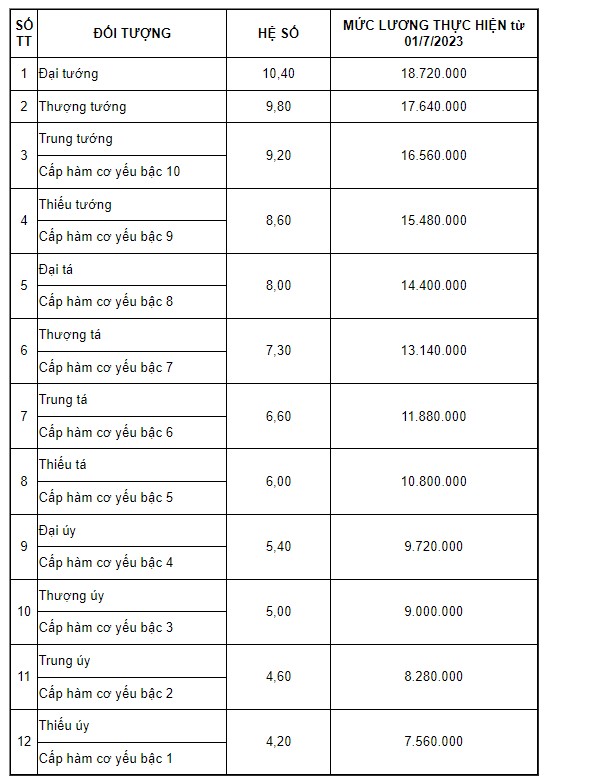What is the new salary table of officers after salary reform in Vietnam according to Resolution 27-NQ/TW?
What is the current salary table of officers in Vietnam?
Pursuant to the regulations in Appendix I issued with Circular 41/2023/TT-BQP stipulating the summary of salary tables and salary increases of the military from July 1, 2023 as follows:

What is the new salary table of officers after salary reform according to Resolution 27-NQ/TW?
Pursuant to subsection 3, Section II of Resolution 27-NQ/TW of 2018, it is clearly stated as follows:
For officials, public employees and armed forces (public sector)
....
- Develop a professional and professional salary table according to official ranks and official professional titles, applicable generally to officials and public employees who do not hold leadership positions; Each official rank and professional title has many salary levels according to the principle: The same level of job complexity means the same salary; Working conditions are higher than normal and job incentives are implemented through job-based allowances; Rearrange the rank groups and number of ranks in official ranks and official professional titles, encourage officials and public employees to improve their professional qualifications and skills. Appointment to official ranks or public employee professional titles must be linked to the job position and structure of official ranks and public employee professional titles by the agency, organization or unit managing officials and public employees.
- Develop 3 salary tables for the armed forces, including: 1 salary table for officers, and non-commissioned police officers (according to position, title, and military rank or rank); 1 salary table for professional military personnel, professional technical police and 1 salary table for defense workers and police workers (which maintains the salary ratio of the armed forces compared to the current salary of administrative officials) .
Accordingly, after salary reform, 3 salary tables will be developed for the armed forces, including:
- 1 salary table for officers, professional non-commissioned officers of the Police (according to position, title and military rank or rank);
- 1 salary table for professional military personnel and police technical expertise;
- 1 salary table for defense workers and police workers (which maintains the salary correlation of the armed forces compared to the current administrative officials).
In particular, a salary table for officers will be built according to position, title and military rank or rank.
At the same time, Resolution 27-NQ/TW of 2018 also clearly stated the military salary structure as follows:
For officials, public employees and armed forces (public sector)
a) Design a new salary structure including: Basic salary (accounting for about 70% of the total salary budget) and allowances (accounting for about 30% of the total salary budget). Additional bonus (bonus fund equals about 10% of the year's total salary fund, excluding allowances).
Accordingly, the salary of officers will be designed as follows:
Salary = Base pay + allowances.
There may also be additional bonuses.

What is the new salary table of officers after salary reform in Vietnam according to Resolution 27-NQ/TW?
What are the military allowances after salary reform in Vietnam according to Resolution 27-NQ/TW?
In subsection 3, Section II of Resolution 27-NQ/TW of 2018, it is clearly stated as follows:
d) Rearrange current allowance regimes, ensuring that the total allowance fund accounts for a maximum of 30% of the total salary budget
- Continue to apply part-time allowance; excess seniority allowance; regional allowances; work responsibility allowance; mobility allowance; Allowances for security, national defense and special allowances for the armed forces (army, police, cipher).
- Combine job-based preferential allowances, job-specific responsibility allowances and toxic and dangerous allowances (collectively referred to as job-based allowances) applicable to officials and public employees of occupations and jobs with working conditions higher than normal and there are appropriate preferential policies of the State (education and training, health care, courts, procuracy, civil judgment enforcement, inspection, examination, auditing, customs, forest rangers, market management,...). Combine special allowances, attraction allowances and long-term work allowances in areas with particularly difficult socio-economic conditions into work allowances in especially difficult areas.
- Annul seniority allowances (except for the military, police, and cipher to ensure salary correlation with officials and officials); leadership position allowances (due to leadership positions in the political system, position salaries are determined); allowances for party work and socio-political organizations; civil service allowances (included in the basic salary); toxic and dangerous allowances (because working conditions with toxic and dangerous elements have been included in occupational allowances).
- Supplement regulations on allowances according to administrative unit classification for commune, district and provincial levels.
- Consistently implement monthly allowance funds for part-time workers at the commune level, in villages and residential groups based on the regular expenditure rate of the Commune People's Committee; At the same time, regulate the maximum number of part-time workers for each type of commune, village, and residential group. On that basis, the People's Committee at the commune level submits to the People's Council at the same level to specifically stipulate the titles eligible for allowances in the direction that one title can undertake many jobs but must ensure the quality and efficiency of work.
Thus, special notes on Military allowances according to Resolution 27-NQ/TW of 2018 are as follows:
- Continue to apply allowances for security, national defense and special allowances for the armed forces
- Continue to apply seniority allowances
- Annul allowances for leadership positions, allowances for party work, and socio-political organizations; Civil service allowances (included in the base pay).
LawNet
